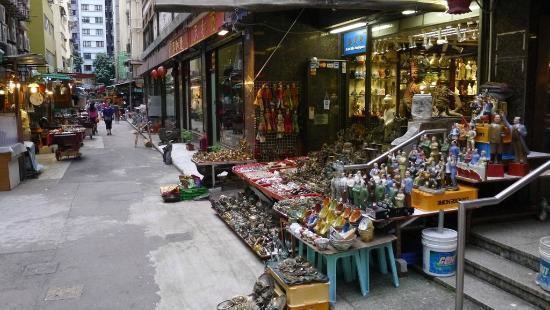Traditional Chinese 摩羅街 Hanyu Pinyin | Status Pedestrianized Simplified Chinese 摩罗街 | |
 | ||
Length 225 m (738 ft)Upper Lascar Row: 168 metres (551 ft)Lower Lascar Row: 57 metres (187 ft) | ||
Lascar Row is the combined name of two streets between Hollywood Road and Queen's Road Central in Sheung Wan, Hong Kong. The streets are Upper Lascar Row (摩羅上街) and Lower Lascar Row. "Lascar Row" usually refers to the former, since most of Lower Lascar Row was redesigned for vehicular traffic and renamed Lok Ku Road. With many antique shops, Lascar Row is a popular tourist destination.
Contents
- Map of Upper Lascar Row Tai Ping Shan Hong Kong
- Name
- Other names
- Upper Lascar Row
- History
- Shops and products
- Renaming request
- Nearby streets
- Notable buildings and landmarks
- Public transport
- References
Map of Upper Lascar Row, Tai Ping Shan, Hong Kong
Name
Although 摩囉 is not in the Chinese dictionary, its meaning stems from the English word lascar. Derived from the Arab-Persian lashkar (military camp), it was used by the British to refer to South Asian seamen. The word 摩囉 comes from "Musselmen", Muslims from the Middle East who traded in China. Early Europeans in Southeast Asia used mouro in Portuguese or morro in Spanish, and Musselmen gradually became "Morra". "Row" derives from the row of houses which accommodated South Asian seamen.
Other names
The South Asian community had a small market. Since the 1920s it gradually developed as a market for a wide range of antiques, including obsolete electrical appliances. It and the neighbouring Hollywood Road became known as Antiques Street.
Cat Street (貓街) derives from the sale by some shops of stolen goods, known as "mouse goods" (老鼠貨) in Chinese. With its lower prices, many were attracted to shop in the area. Shoppers who walked cautiously down the street while selecting their goods were likened to cats trying to catch a mouse. Foreigners, particularly, came to refer to Lascar Row as Cat Street.
Upper Lascar Row
Upper Lascar Row is a narrow alley in Mid-Levels which runs parallel to Hollywood Road on the north side. The straight alley measures over 500 feet (150 m), and there was an Indian police dormitory in the street. On 11 February 1911 a fire broke out on Upper and Lower Lascar Row, destroying 16 houses and damaging another 24.
History
In Chinese, it is common to use 摩囉 ("Moors") to refer to South Asians from India, Pakistan, Bangladesh and Sri Lanka. This reflects the pre-European colonial role of Muslim South Asian trading connections with southern China. The S61 and S62 historic blocks of the former Whitfield Barracks at Kowloon Park in Tsim Sha Tsui are known as the Moors Soldiers Barracks (摩囉兵營).
Shops and products
Hollywood Road and Upper Lascar Row's antiques shops have copper mirrors, electric fans, jade gems, watches, ancient coins, Qing dynasty vases, stamps, newspapers and calendars.
Renaming request
In 2010, eight district officers from the Central and Western District expressed the objection by South Asians to the Cantonese word 「摩羅」 and asked the Hong Kong government to consider changing the name of the street. However, the Lands Department ruled that it did not find the word offensive to South Asians. According to some officers, the refusal reflected government indifference to discrimination against ethnic minorities.
The Democratic Party criticised the government for not considering the sensibilities of South Asia, saying that the term is pejorative. According to the government, a name change would diminish the alley's historical value and the word Mouro is neutral. Inconvenience was also cited, since the street name "Upper Lascar Row" has been used for more than a century. Public input was suggested before any name change.
Nearby streets
Notable buildings and landmarks
Public transport
Lascar Row is served by several bus lines and the Mass Transit Railway (MTR).
